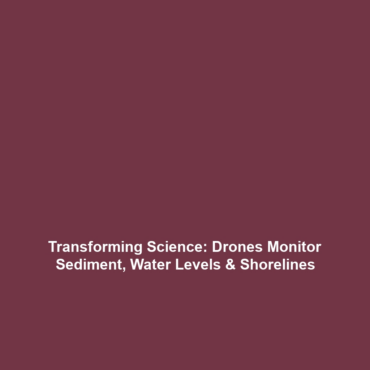The Role of Drones in Tracking Sediment Movement, Water Levels, and Shoreline Changes
Drones are revolutionizing the way scientists study environmental changes, particularly in the context of tracking sediment movement, monitoring water levels, and analyzing shoreline changes. As integral tools within the realm of Drones in Science, these unmanned aerial vehicles enable researchers to gather crucial data efficiently and accurately. Their applications span numerous fields, from environmental conservation to urban planning, highlighting their significance in understanding and managing our ecosystems.
Key Concepts
Understanding the role of drones in environmental studies requires familiarity with several key concepts:
- Remote Sensing: Drones utilize sensors to collect data about the Earth’s surface without physical interaction, essential for tracking sediment movement and water levels.
- Geographical Information Systems (GIS): Drones can integrate collected data into GIS platforms, facilitating spatial analysis of shoreline changes over time.
- Real-time Data Collection: Drones enable scientists to monitor dynamic environments in real-time, improving responsiveness to environmental changes.
These principles underscore the importance of drones in scientific research, particularly in tracking sediment movement, water levels, and changes in shorelines.
Applications and Real-World Uses
The application of drones for tracking sediment movement, water levels, and shoreline changes has transformed scientific research methodologies. Some significant uses include:
- Coastal Erosion Monitoring: Drones provide high-resolution imagery critical for analyzing and predicting shoreline retreat caused by erosion.
- Wetland Assessment: Monitoring water levels in wetlands through drone surveys assists conservation efforts by assessing habitat health and biodiversity.
- Riverbank Analysis: Drones offer detailed insights into sediment transport processes, aiding in the management of river systems.
These applications of drones in tracking sediment movement, water levels, and shoreline changes exemplify their importance in advancing scientific understanding within the broad category of Drones in Science.
Current Challenges
Despite the benefits, there are several challenges faced in utilizing drones for tracking sediment movement, water levels, and shoreline changes:
- Data Accuracy: Ensuring the precision of data collected by drones remains a significant issue.
- Regulatory Restrictions: Drone operations are subject to regulatory limitations that can impede research efforts.
- Technical Limitations: Battery life and payload capacity may restrict prolonged data collection missions.
Addressing these challenges in tracking sediment movement and shoreline changes is crucial for the successful integration of drones in scientific research.
Future Research and Innovations
As technology continues to evolve, the future of drones in environmental science looks promising. Key areas of innovation include:
- Enhanced Sensor Technology: Next-generation sensors will improve the accuracy of data collection, particularly in complex environments.
- AI Integration: Incorporating artificial intelligence for data analysis can facilitate better predictive modeling for shoreline changes.
- Autonomous Operations: Research into fully autonomous drone systems may streamline data collection processes, reducing human intervention.
These upcoming innovations will undoubtedly play a vital role in the future of Drones in Science.
Conclusion
In summary, the role of drones in tracking sediment movement, water levels, and shoreline changes is a transformative aspect of modern scientific inquiry. These technologies are paving the way for more efficient, accurate, and extensive environmental monitoring. As research progresses, the potential for drones to influence scientific fields continues to grow. For further reading on similar topics, check out our article on drone uses in agriculture and the impacts of drones on wildlife research.
